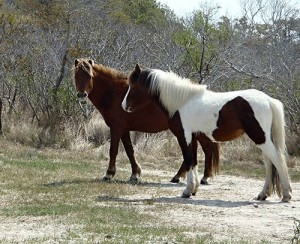
ASSATEAGUE — A soap opera of sorts is unfolding this week on Assateague with the announcement one of the 29 foals is pregnant, but questions remain about who the sire might be.
Assateague Island biological technician Allison Turner spent much of November following the 29 mares in the population of wild horses on the barrier island waiting for them to defecate. Turner collected the samples, which were then frozen and sent to a lab to determine which if any of the mares will be expecting a foal this year.
Last week, the Assateague Island Alliance (AIA), the friends group of the Assateague Island National Seashore, announced the testing had been completed and just one of the 29 mares on the island is currently pregnant. The sorrel mare Jojo has tested positive for pregnancy and will birth a foal sometime in the coming months. What remains a mystery, however, is just who the father might be.
The wild horses on Assateague carry their foals for about 11 and a half months, putting the birth likely sometime this summer or early fall. Because Assateague officials can’t tell from the test just how long Jojo has been pregnant, it is too early to say who the sire might be. It’s an answer they barrier island’s staffers will not likely know until the foal is born and even then there is little certainty.
This much is known. Jojo was part of Charcoal’s band at the end of last March. However, she was hanging out with Llama Boy’s band when the population was surveyed in May and has been with him since. Complicating the issue further, Llama’s Boy has four mares including Tipperary, whose 4-year-old Pinto named Dewey is still with the band. Dewey was with Llama Boy’s band around the time Jojo got pregnant, so it remains a possibility Dewey could also be the sire.
So, while it reads like a soap opera or a nighttime reality show, it remains uncertain who the sire of Jojo’s foal is, but it could be Charcoal, Llama’s Boy or even the young Dewey. AIA staffers will likely learn a lot more when the foal is born later this year as many of the genetic traits including color and pattern are passed down from the sire and dam to the foal.
Tracking the wild horses on Assateague and cataloging their birth habits is serious business as the National Park Service and the AIA attempt to manage the size of the herd. Throughout November, Turner collected fecal samples from the 29 mares in the wild horse population on Assateague and the samples were later analyzed to determine which if any of the mares were carrying foals.
While certainly not glamorous, collecting the fecal samples allow Assateague officials to carefully monitor and manage the size of the wild herd on the island.
What is fairly scientific, however, is the complex contraceptive program administered on the wild horses on Assateague put in place several years ago to effectively reduce and manage the size of the herd. In the interest of managing the herd size, which, if left unchecked would overtake the barrier island and gobble up the very natural resources the animals need to survive, the National Park Service several years ago began an contraceptive program for the mares in the herd.
Selected mares are injected with a non-invasive contraceptive called PZP in an effort to prevent multiple births by the same mare in an effort to maintain and shrink the size of the herd to its manageable threshold. Assateague’s contraceptive program has become the model for wild horse and other animal management programs around the country. As recently as just a few years ago, the wild horse population on Assateague had swelled to around 140. Just two new foals were birthed on the barrier island last year, which has been the trend in recent years. From a high of around 140 just a few years ago, the size of the Maryland herd now stands at 100 with another foal expected in the coming months.
